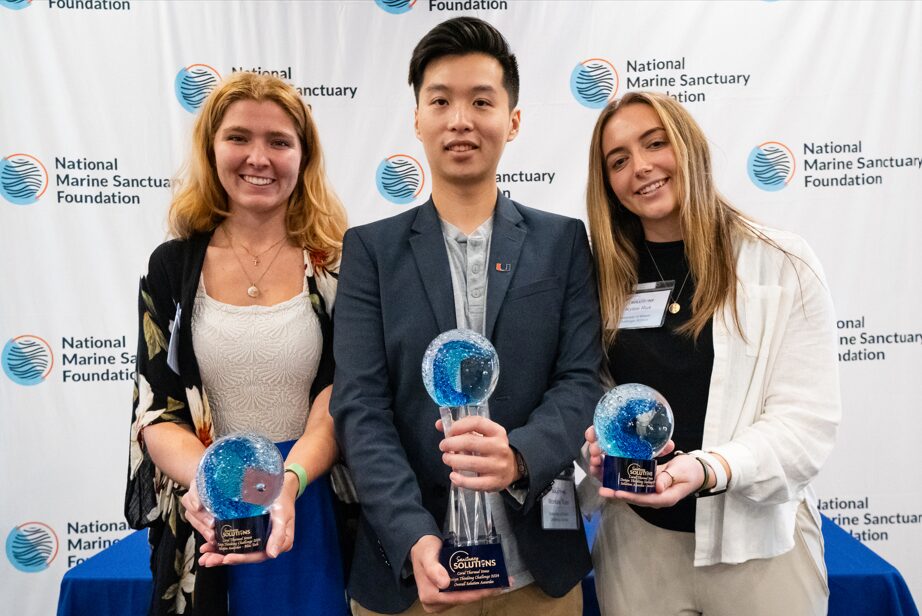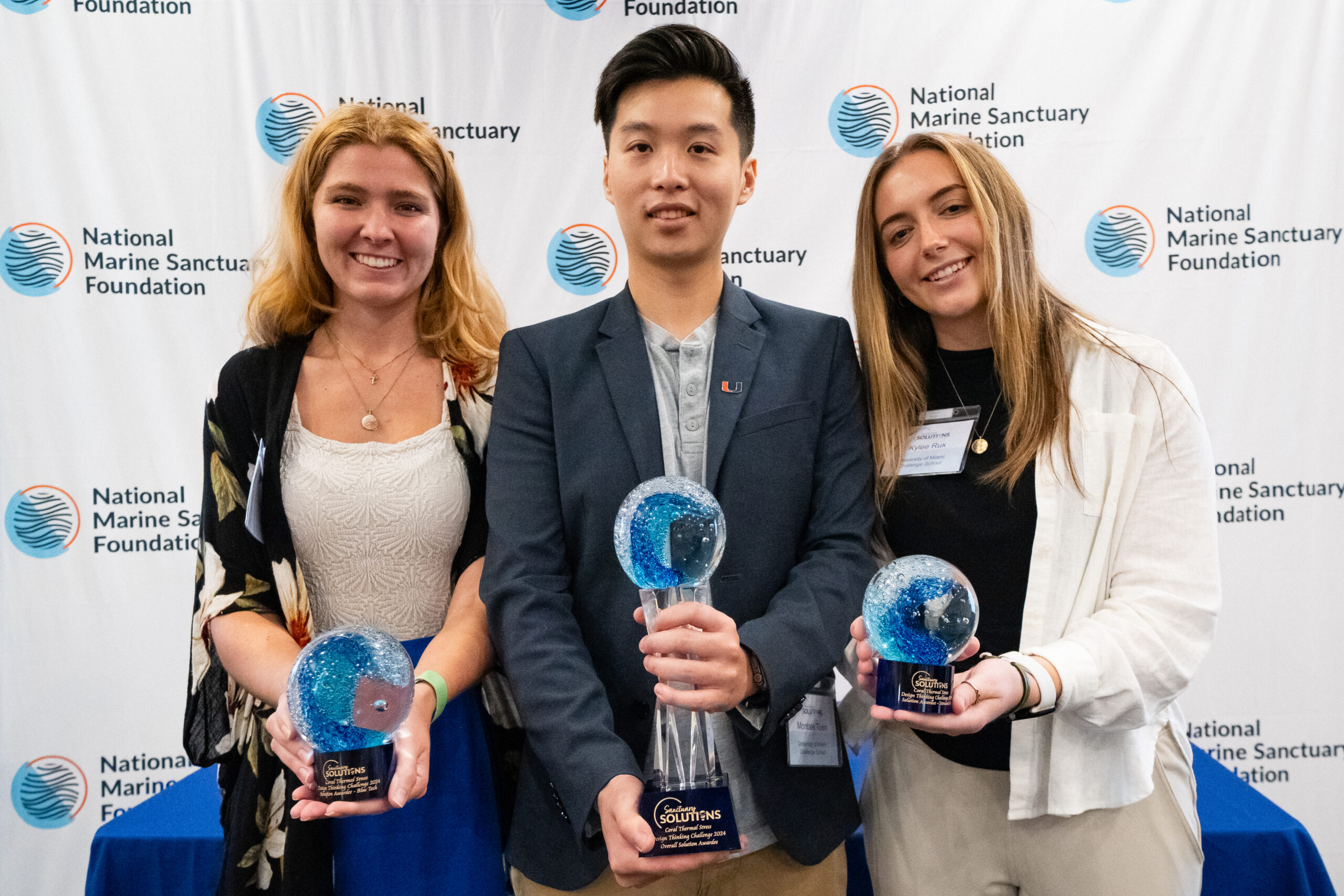
Conservationists, Blue Tech Innovators, and Engineers Combine to Save Corals

Members of the winning University of Miami team: Danielle Bejar, Montale Tuen, Kylee Rux, and Josh Prabahar (not pictured). Photo credit: Tiffany Duong/Ocean Rebels
What happens when coral conservationists, Blue Tech innovators, and engineering students walk into a workshop together?
For a Sanctuary Solutions Series event, the National Marine Sanctuary Foundation hosted a Coral Reef Thermal Stress Design Thinking Challenge & Workshop at Reefhouse Resort & Marina in Key Largo, Florida. A curated group of experts focused on marine engineering solutions to protect coral reefs from heat-driven bleaching events in Florida Keys National Marine Sanctuary, home to the only living barrier coral reef in North America. Participants included 62 attendees from over 20 different organizations, representing restoration practitioners, conservation and stewardship professionals, Blue Tech innovators, government managers, and nonprofit experts.
This challenge occurred while the world is experiencing the fourth global coral bleaching event, in the wake of an unprecedented marine heat wave in summer 2023 in Florida Keys National Marine Sanctuary. One of the lessons learned from the rapid response to this heat wave was that while the coral restoration community maintains expertise in coral biology, physiology, and life history, there is a need to incorporate diverse perspectives from the marine engineering sector to design and deploy large-scale solutions to protect corals from thermal stress.
With only 5 months and a limited budget, four top marine engineering schools – the University of Delaware, Georgia Institute of Technology, the University of Miami, and Texas A&M University – independently designed solutions to protect large coral reef sites (i.e. 70,000+ square miles) from thermal stress events (i.e. increased sunlight and water temperatures). The solutions proposed should mitigate the thermal stress events by reducing corals’ exposure to light levels and/or temperature effects during the summer months.
The University of Delaware team presented two solutions: the JAIAbot (an AUV to assist with coral shading), and a method of decreasing water temperatures with coral chillers and a micro-bubbler. Georgia Tech presented an integrated approach to artificial upwelling with additional acoustic monitoring to inform deployment. The Texas A&M team’s solution (The Aggie Network) proposed an artificial upwelling solution for local cooling during stress events. Finally, the University of Miami team presented two solutions: Coral Canopy and HexHive which would provide localized shade cover in targeted reef areas from interconnected floating hexagons made of a UV-resistant filter fabric bordered by air-filled floats and fenders that could be rapidly deployed on the water’s surface above coral reef sites to reduce harmful UV transmission. This modular design can be expanded to cover large surface areas, using mooring balls as anchor points.
After an in-depth group discussion of each solution and the practicalities of implementation, experts from blue tech/engineering, management, restoration in practice, and stewardship evaluated each solution and gave quantitative and qualitative feedback. Attendees discussed the role of stewardship and the pipeline from awareness to action, the role of risk tolerance (both perceived and actual risks), and opportunities for restoration practitioners and blue tech to support and nurture small scale solutions. Some considerations brought up by the experts included energy and financial costs of installation and maintenance, materials used, and real-world water and weather conditions, and the need for revenue generation or funding mechanisms through industry partnerships.
To determine the overall winner of the Design Thinking Challenge, every attendee had the opportunity to “invest” a total of $100 of “Solutions Dollars” into any of the six solutions proposed by the four challenge schools. Awards in the categories of Stewardship, Management, Restoration in Practice, and Blue Tech/Engineering were decided based on the feedback from the experts present.
Overall Winner: University of Miami (HexHive)
Stewardship Award: University of Miami
Blue Tech/Engineering Award: University of Miami
Management Award: University of Delaware (JAIAbot)
Restoration in Practice Award: Texas A&M (The Aggie Network)
As the overall winners of the Design Thinking Challenge, the University of Miami team members Kylee Rux, Danielle Bejar, Montale Tuen, and Josh Prabahar and their team advisor Prannoy Suraneni, received an additional $10,000 in funding for continued work (such as physical prototyping) and the opportunity to attend both Reef Futures 2024 and Capitol Hill Ocean Week 2025.
At Capitol Hill Ocean Week 2025, the University of Miami team members presented their HexHive solution to a packed room of CHOW participants in the Sanctuary Cinema.
Following the challenge, the team is working to fine-tune their HexHive design alongside marine experts and restoration practitioners to prepare to test their prototype in summer/fall 2025.
This Sanctuary Solutions Series event demonstrated the National Marine Sanctuary Foundation’s continued commitment to national marine sanctuaries as sources of innovative solutions for real-world problems and empowering the next generation of underwater scientists.
Our deepest thanks to the National Oceanic and Atmospheric Administration (NOAA), Florida Keys National Marine Sanctuary, NOAA Coral Reef Conservation Program, NOAA Office of Habitat Conservation, the Mission: Iconic Reefs Program, as well as the Coral Restoration Foundation, I.CARE, Mote Marine Laboratory, Reef Renewal USA, Rescue a Reef, BSA Sea Base, the Southeast Florida Action Network (SEAFAN), Kuleana Coral, Marine Conservation Costa Rica, and Reef Renewal Bonaire, Coral Research & Development Accelerator Platform (CORDAP), Oceanetics, the Reef Restoration and Adaptation Program (RRAP), Seaworthy Collective, The Nature Conservancy, and the University of Florida.
This opportunity was funded through a National Fish and Wildlife Foundation (NFWF) National Coastal Resilience Fund award to the National Marine Sanctuary Foundation.
